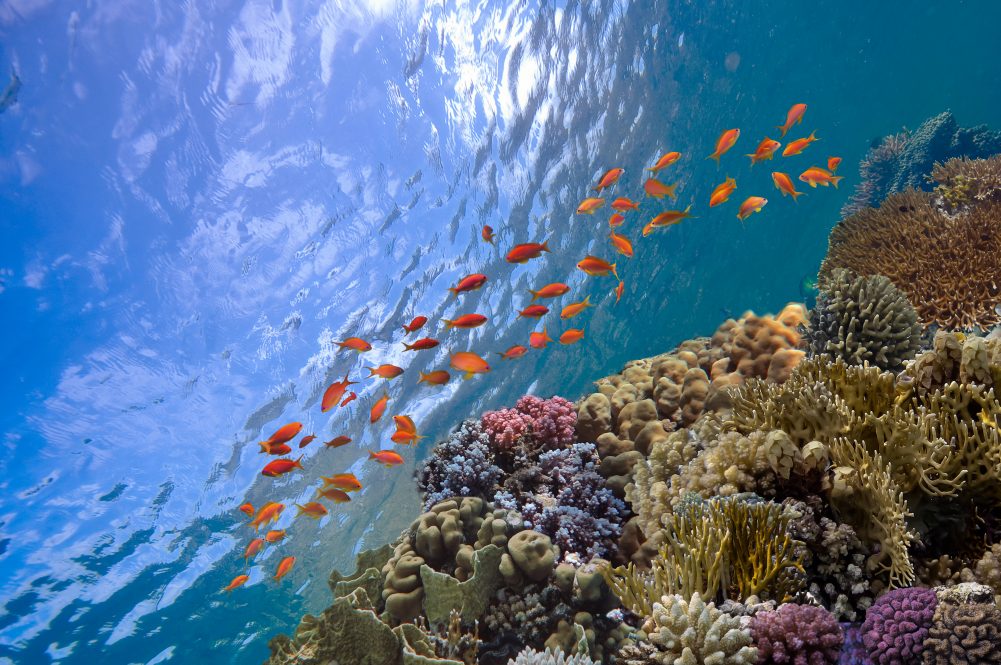As global temperatures rise, so do ocean temperatures. The ocean absorbs around 90% of the world’s excess heat, and this leads to changes to the marine environment that go beyond temperature, making some areas uninhabitable for some marine species.
Researchers are working to understand and anticipate how these environmental changes will impact marine habitat shifts. A team of scientists, including UConn Department of Marine Science researchers Zhuomin (Jasmine) Chen and Samantha Siedlecki, is working together to improve forecasts of the habitat shifts for different marine species. Their findings are published in Nature Communications.
Habitats shift or shrink as marine species seek environments suitable for their survival and for satisfying other essential ecological activities such as growth, feeding, and reproduction. The ability to anticipate these shifts has great value for policymaking, research, and helping the fishing industry cope with the changing environment.
Chen explains that the multidisciplinary team predicted interannual-to-decadal habitat shifts for diverse marine species in the upper 600 meters of 11 North American Large Marine Ecosystems (LMEs), based on a key metabolic index combined with a suite of decadal forecast systems. The index was developed previously by another research group, and it indicates habitat viability; and the decadal forecast system is called the Community Earth System Model-Decadal Prediction Large Ensemble (CESM-DPLE) developed by the National Center for Atmospheric Research.
“Right now, marine species habitat forecasts usually have a relatively narrow focus on the environmental variables that shape the distribution of species, typically using temperature as the major or sole determinant of the ecological niche predictions. However, our work breaks with that tradition by highlighting the potential that oxygen can play a role in deriving marine habitat shifts,” says Chen.
Higher predictability of viability for marine life
Hypoxic conditions result when levels of oxygen are low. The researchers focused on species with two key metabolic traits – temperature sensitivity of hypoxia vulnerability, and hypoxic tolerance, which are both defined within the Metabolic Index framework and have been determined for a diversity of species using previously published laboratory and field data. They focused on species that fell into three different groups, called ecotypes, depending on their temperature sensitivities and metabolic needs, they designated low, medium, and high.
“The Metabolic Index was originally defined as a ratio of environmental oxygen supply to an organism’s resting metabolic demand, which considers both oxygen availability and temperature effects. For marine habitats to be metabolically viable, the ratio must be larger than a critical value of one for resting metabolism or larger than a larger-than-one critical value for active metabolism. Therefore, in this study, we focus on a normalized Metabolic Index for a consistent critical value of both resting and active metabolisms,” says Chen.
By selecting representative ecotypes with low, medium, and high temperature sensitivity traits and the same hypoxic tolerance trait, the researchers found that these traits correspond to different viable habitat distributions in space, as well as their interannual shifts in both horizontal and vertical directions, integrating both spatial differences and interannual variabilities of the environmental variables like oxygen and temperature. Chen says the results show that the interannual shifts of viable habitats for medium- and high- temperature-sensitivity species are generally meridional, suggesting the species would have northward contraction of viable habitats with the southern boundaries retreated northward in response to warming or deoxygenation. While the viable habitats of low-temperature-sensitivity species have not only meridional contractions in the northern high-latitudes but also longitudinal shifts along the southwest coast of North America.
The researchers found that the CESM-DPLE system combined with the eco-physiological framework provides significantly higher predictability of habitat viability for diverse marine species in the 11 North American Large Marine Ecosystems than that of simple persistence forecasts almost everywhere and at every lead year, with improved predictability mainly in the subsurface.
As habitats shift, a greater need for accurate predictions
Chen says that different regions may have different environmental driver variables that dominantly contribute to predictability. The researchers used a method called Taylor linear decomposition to look more closely at the variables to single out the driver of predictability in each Large Marine Ecosystem. In most cases, oxygen was the dominant driver of predictability, especially for those Northeast Pacific regions, but not always.
“We did identify some regions – for example, the inner-shelf of the eastern Bering Sea – with limited contribution to predictability from the oxygen component, but the temperature component is relatively dominant for the predictability in these regions,” says Chen.
For the northeast coast, Chen explains the temperature component is an important or even determinant driver of predictability, probably because of the relaxation of the oxygen constraint on habitat viability due to strong ventilation processes in these high-latitude regions.
By using the decadal prediction system combined with the eco-physiological mechanistic framework, Chen explains the habitat forecast products can be fully employed for living marine resource management and decision-making in response to changing ocean conditions,
“We are mainly focusing on the interannual to decadal timescale, which is a very important time horizon for decision-making and marine resource management to reduce impacts, promote resilience, and maximize the value of living marine resources in the face of changing ocean conditions.”
Predicting spatial distributions of viable habitats will become increasingly important for things like habitat shifts. For example, Chen says northward habitat contractions can make it infeasible to fish from certain ports, while southward habitat expansion opens ports that would need to be prepared for processing the landings, these will probably impact the fishing industry. There are also substantial ecological impacts to consider, Chen says.
“Unequal spatial and vertical habitat shifts of species due to their different metabolic traits, for example, different temperature sensitivity traits, may lead to substantial changes in prey-predator dynamics and ecosystem structure, for example, the overlap of viable habitats of southern and northern silver hake with juveniles as prey and adults as predator, which may affect resource availability to the fishery and require adaption by stakeholders,” says Chen.



